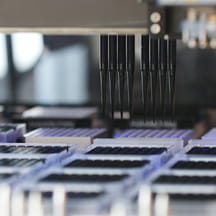A few days ago, the mother of a little girl who cannot speak and has barely communicated came out of our hospital’s assistive technology (AT) area and began to weep. I approached her and asked if she was alright. She nodded through the tears and then looked up at me, smiling. “My daughter just told me she likes the color blue.”
Some children live locked in silence. Though they have much to say, they cannot speak. Some cannot move or control their bodies. Others face a grim future of gradual loss of speech or movement, or both. Whatever their diagnosis, they are still children. They want to reach out to the world and share their feelings, thoughts and wishes; let you know when they’re thirsty, happy or in pain; participate in class, listen to music, email their friends; and say, “I love you” to their parents.
AT enables them to do these things. It is equipment that improves the functional capabilities of a child with a disability, at school, at home and in the community. It supports a child in the functions of daily life. AT is opening a door for a locked-in child. It helps a boy with autism speak through his voiced keyboard and tell a toy car to “Go!” His eyes light up as it zips across the room.
It helps a teenager who has lost speech and most movement after an accident but can slowly drag a finger to a large, ultra-sensitive joystick to answer “yes” or “no” on his computer to questions of whether he is in pain, likes a music group, or needs a hug.
Helping these children connect with their world involves a set of miracle workers: speech, occupational and physical therapists who work as a team, each using specialized expertise, patience and endless encouragement. They create individualized solutions using AT, and they share the joy of families that watch their emotionally shuttered children engage and flourish.
Who can AT help?
AT can help kids with cerebral palsy, autism, muscular dystrophy, spinal cord injury, stroke, developmental delays, visual impairments, burns, traumatic brain injuries and neuro-muscular disorders, including degenerative diseases. Most of us know families that include these children. They’re the most vulnerable of the vulnerable, and we can make their lives better.
But there is more to be discovered, and increased funding is an essential component of research and accessibility. So is more widespread training. Too few teachers and families know how to use AT tools. Training is essential so a child whose world is unlocked in a hospital does not see it close up again when he returns to home and school.
If you are a speech, occupational or physical therapist; a teacher; a pediatrician, neurologist or rehabilitation physician; a special needs advocate; director of a clinical training program or a leader of an assistive technology company, join me in focusing attention on these kids.
Let’s work with parties responsible for funding decisions. Let’s share information about needs and solutions, what’s currently available and areas of promising research; and let’s make assistive technology accessible to as many kids as possible. Together, we can rescue the children who are hostages in their own bodies and give them the keys to unlock their world.



